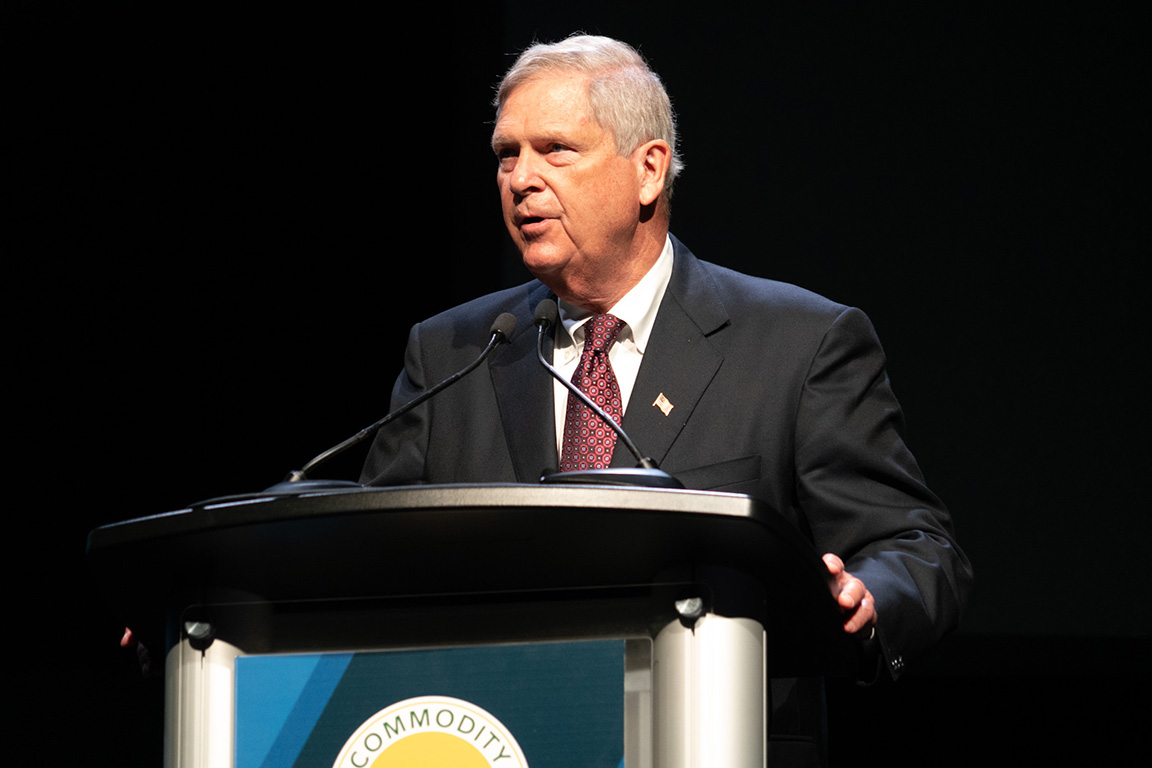
(Photo: Joseph Hopper/Iowa Soybean Association)
Vilsack touts more trade, domestic fertilizer production and climate smart ag to boost farm revenue
March 11, 2022 | Aaron Putze, APR
America’s top ag official took to the stage at Commodity Classic in New Orleans to announce four U.S. trade missions, the expansion of farm revenue streams involving climate smart ag programs and incentives to spur more domestic fertilizer production.
U.S. Department of Agriculture (USDA) Secretary Tom Vilsack said his team will act on these measures to boost the fortunes of U.S. farmers impacted by soaring input prices and global food instabilities caused by Russia’s invasion of Ukraine.
The former Iowa governor spoke to nearly 1,500 farmers gathered in the Crescent City for the annual meeting of soybean, corn, sorghum and wheat associations. His appearance occurred just moments after conversing with Roman Lashchenko, Ukraine’s minister of agriculture.
“What incredible courage it takes to visit with us and plead for help from a bunker surrounded by sandbags,” Vilsack said. “As I spoke with him, it impressed upon me the importance of all of us who live in a free and democratic country to never take that for granted.”
Vilsack said Lashchenko pressed for additional fuel supplies needed for farming applications in Ukraine and for measures to maintain global food security.
The conversation reminded Vilsack of the ongoing value and importance of domestic agriculture and the work of U.S. farmers.
“The reason we can celebrate freedom is because of the people in this room and the hundreds of thousands of farmers and ranchers who raise their families in America,” he said. “What you have done and do have allowed this country to grow and expand.”
Vilsack pledged to use the USDA’s resources and authority to create more and better markets that allow producers to gain more of the value and wealth they create.
“For far too long, your hard work has resulted in wealth and opportunity created somewhere else,” he said.
Diversifying sales
A diversification of U.S. exports beyond China will aid in these efforts, a lesson learned from the recent trade impasse involving both countries.
Prior to imposing tariffs on Chinese imports in July 2018, the U.S. accounted for nearly 25% of all Chinese ag imports. Despite an easing of the tariffs and trade war rhetoric, the U.S. accounts for just 18% of Chinese ag imports.
Much like China diversified its import portfolio, Vilsack said the U.S. must expand where it markets and sells agricultural commodities.
Building on record U.S. exports totaling $170 billion last year, the USDA will lead trade missions this year to the United Kingdom, Philippines, Kenya and Spain.
“These efforts will expand opportunities for U.S. farmers and make sure we’re in the position to trade,” he said.

More revenue streams
Climate smart agriculture can also provide new and expanded revenue streams for farmers. Vilsack said producers who have invested in conservation practices or commit to installing new ones should be rewarded.
Yet no standard exists for marketing and measuring climate-related outcomes associated with ag production.
The USDA is committed to establishing those standards, Vilsack said, by embarking on a series of pilot projects across all commodities. It will aggregate the activities, provide resources to assist those involved in climate smart ag (both existing and new practices) and measure and quantify results.
The outcome will be development of a climate smart ag standard that can then be marketed and verified. To kickstart the process, USDA is providing $1 billion in climate smart ag grants. The application deadline for these grants has been extended 30 days to May 6 due to strong interest.
Soaring prices
Addressing soaring fertilizer prices is also a USDA priority, said Vilsack.
A recent visit to Iowa State University offered the Mt. Pleasant native a “sneak peek” at sensor technology used in corn production that could reduce fertilizer use.
“Some studies show that, at least in the Midwest, 30% of the acres using fertilizer may not need fertilizer at all,” he said.
U.S. farmers have become too reliant on foreign sources of fertilizer, including countries “who may not see things the way we do,” Vilsack added. USDA will provide grants totaling $250 million to jumpstart independent, domestic fertilizer production.
Vilsack also:
- Referenced the need to expand renewable fuels production under the backdrop of surging inflation, soaring fuel prices and geopolitical unrest in key regions prolific in corn and wheat production. “We continue to look for ways to deal with immediacy of the fuel challenge and look to the long-term of E15, B20 and sustainable aviation fuel.” He did not reference the administration’s push for electric vehicles or the implications such policy might have on liquid fuel demand, including biodiesel and renewable diesel.
- Signaled his frustration of congested ports and vessels departing U.S. shores with empty containers. He said the department is incentivizing containers to be filled with American agricultural products. “There’s no reason why any container leaving our ports should be empty.”
- Reminded farmers to be ambassadors for trade. “Some may see trade as a net-negative, which is why we must enforce trade agreements,” he said. “But if we’re going to create new markets and create an economy for farmers that rises from the bottom and out, then we’re going to have to export.”
- Highlighted the department’s efforts to expand livestock processing capacity while administering grants to increase warehousing, cold storage, and workforce development. “This will create more competition and ensure farmers get a fair shake in the marketplace.”
Back